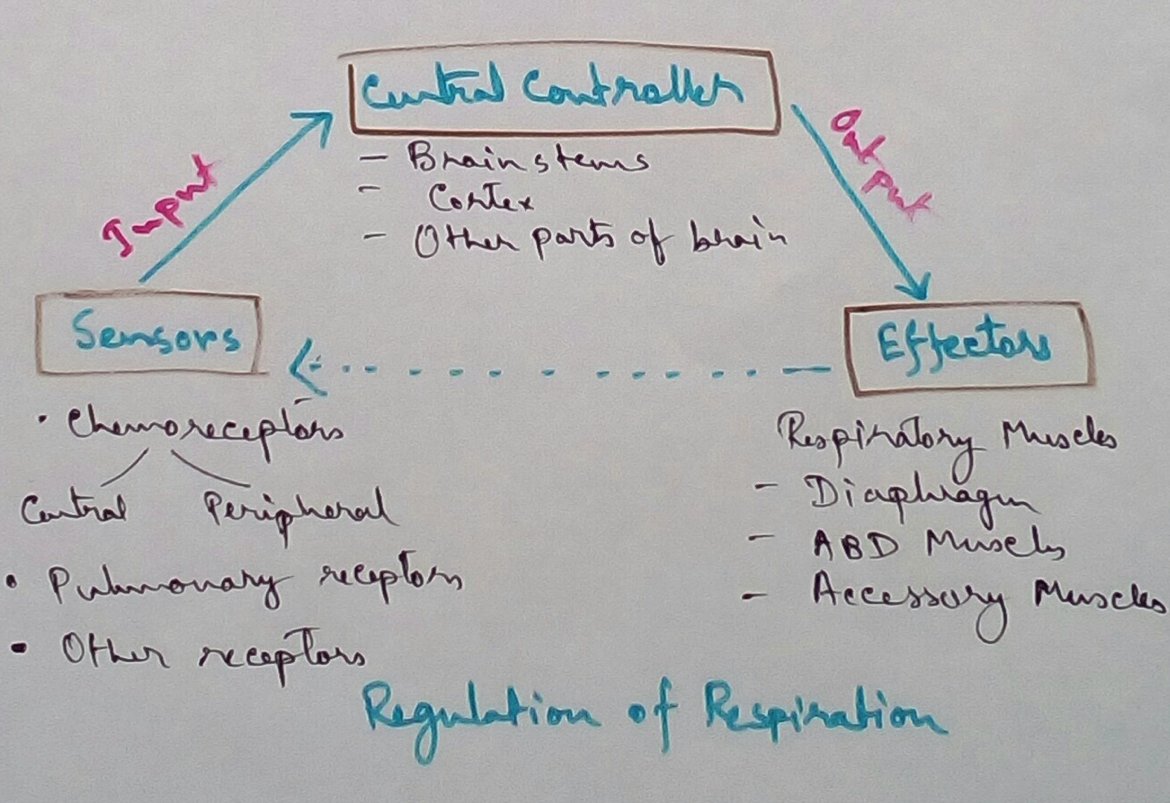Regulation of Respiration
Respiratory Centres - Respiratory Centre is the area that controls the rate of respiration and it is observed to be located in medulla oblongata and pons. Respiratory Centre has the following will dispersed components like inspiratory area pneumotaxic area, expiratory area, chemosensitive area.
Inspiratory Area - Inspiratory area is observed to be located along the length of medulla weak neurones interconnected two sensory termination of glossopharyngeal and vagus nerve glossopharyngeal is a sensory signals from peripheral chemoreceptors and Vegas is a sensory signals from lungs and stretch receptors of bronchi. The area is connected through nerves to inspiratory muscles.
Pneumotaxic Area- Pneumotaxic area is observed to be offers in ponds and is meant for setting the inspiratory area where limit of respiration is reached.
Expiratory Area - Exploratory area is fine to be located along the length of the Middle Earth and it remains dormant it’s it when respiratory muscles are to be stimulated as during strenuous exercise.
Chemosensitive Area - Chemosensitive area lies in the middle and near the place of entry of glossopharyngeal and vegus nerve and it is sensitive to black carbon dioxide and hydrogen ion concentration. Chemosensitive area is connected to the other areas of respiratory centres and chemoreceptors are located on catoteid and aortic arteries which are sensitive to oxygen deficiency in arterial blood. This chemoreceptor Saint information to respiratory centre.
Chemical Receptors - Chemical mechanism of regulation are observed to be done by chemoreceptors which are present in the body and eat activity is regulated by the increase or decrease in the chemical composition of blood. Chemoreceptors can be divided according to their position and function into two parts-
Central Chemoreceptors - Central chemoreceptors are observed in the brain as they are sensitive for the change in the hydrogen ion concentration of the blood if the hydrogen ion concentration is increased in the blood they becomes active. Central chemoreceptors are observed in the brain as they stimulate due to decrease hydrogen ion concentration.
Peripheral Chemoreceptors - As the name peripheral chemoreceptors are heard it is observed to be present in the Periphery of the body specially the different peripheral tissues they also associated with the changes in the oxygen Ion concentration in the peripheral tissue region. Peripheral chemoreceptors are observed to be active due to decrease of oxygen Ion concentration in peripheral tissue.
From Regulation of Respiration to HOME PAGE
Recent Articles
-
What Is Plasma? | Blood Plasma | Proteins | Nutrients | Cholesterol
Nov 07, 25 10:29 AM
Blood is a mobile fluid which is a connective tissue and is derived from the mesoderm like cell any other connective tissue. Colour of blood is reddish and that flows inside the blood vessels by means… -
Disorders of Respiratory System | Tuberculosis | Pleurisy | Emphysema
Oct 28, 25 11:39 PM
Tuberculosis is very common disease and is caused by a type of bacteria called Mycobacterium tuberculosis. This disease causes different trouble in the respiration and infection of several parts of th… -
Regulation of Respiration | Respiratory Centres | Inspiratory Area |
Oct 14, 25 12:13 AM
Respiratory Centre is the area that controls the rate of respiration and it is observed to be located in medulla oblongata and pons. Respiratory Centre has the following will dispersed components like… -
Explain Transport of Gases | External Respiration | Tissue Respiration
Oct 09, 25 11:35 PM
In humans gaseous exchange is completed in the following ways the steps are - External Respiration or Breathing - Breathing in false taking in of Oxygen and giving out of carbon dioxide in the body. M… -
Kind and Number of Teeth | Location of Teeth in Mouth | Care of Teeth
Sep 11, 25 12:52 AM
Kind and Number of Teeth






New! Comments
Have your say about what you just read! Leave me a comment in the box below.